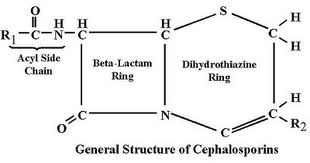CONTROL OF MOS BY ANTIBIOTICS ..
1) INHIBITION OF CELL WALL SYNTHESIS:
Please do not bother to see the following links:
- Cephalosporins: These are class of B-lactam antibiotics originally derived from a marine fungus Cephalosporium acremonium. They are effective against Gram positive & Gram negative bacteria (Broad spectrum antibiotics).
The cephalosporin nucleus can be modified to gain different properties. Cephalosporins are sometimes grouped into "generations" by their antimicrobial properties. The first cephalosporins were designated first-generation cephalosporins, whereas, later, more extended-spectrum cephalosporins were classified as second-generation cephalosporins. Each newer generation has significantly greater Gram-negative antimicrobial properties than the preceding generation, in most cases with decreased activity against Gram-positive organisms. Fourth-generation cephalosporins, however, have true broad-spectrum activity.
| Members | Description | |
|---|---|---|
| 1 | Cefacetrile (cephacetrile), Cefadroxil (cefadroxyl; Duricef), Cephalexin(cefalexin; Keflex), Cefaloglycin (cephaloglycin), Cefalonium (cephalonium),Cefaloridine (cephaloradine), Cefalotin (cephalothin; Keflin), Cefapirin(cephapirin; Cefadryl), Cefatrizine, Cefazaflur, Cefazedone, Cefazolin(cephazolin; Ancef, Kefzol), Cefradine (cephradine; Velosef), Cefroxadine,Ceftezole | Gram-positive: Activity against penicillinase-producing, methicillin-susceptible staphylococci and streptococci(though they are not the drugs of choice for such infections). No activity against methicillin-resistant staphylococci or enterococci. Gram-negative: Activity against Proteus mirabilis, some Escherichia coli, and Klebsiella pneumoniae ("PEcK"), but have no activity against Bacteroides fragilis, Pseudomonas, Acinetobacter, Enterobacter, indole-positive Proteus, or Serratia |
| 2 | Cefaclor (Ceclor, Distaclor, Keflor, Raniclor), Cefonicid (Monocid), Cefprozil(cefproxil; Cefzil), Cefuroxime (Zefu, Zinnat, Zinacef, Ceftin, Biofuroksym,[13] Xorimax), Cefuzonam, second-generation cephalosporins with antianaerobe activity: Cefmetazole, Cefotetan, Cefoxitin. The following cephems are also sometimes grouped with second-generation cephalosporins: Carbacephems: loracarbef (Lorabid); Cephamycins:cefbuperazone, cefmetazole (Zefazone), cefminox, cefotetan (Cefotan),cefoxitin (Mefoxin), Cefotiam. | Gram-positive: Less than first-generation. Gram-negative: Greater than first-generation: HEN (Haemophilus influenzae, Enterobacter aerogenes and someNeisseria + the PEcK described above |
| 3 | Cefcapene, Cefdaloxime, Cefdinir (Sefdin, Zinir, Omnicef, Kefnir),Cefditoren, Cefetamet, Cefixime (Fixx, Zifi, Suprax), Cefmenoxime,Cefodizime, Cefotaxime (Claforan), Cefovecin (Convenia), Cefpimizole,Cefpodoxime (Vantin, PECEF), Cefteram, Ceftibuten (Cedax), Ceftiofur,Ceftiolene, Ceftizoxime (Cefizox), Ceftriaxone (Rocephin). Third-generation cephalosporins with antipseudomonal activity: Cefoperazone (Cefobid),Ceftazidime (Fortum, Fortaz). The following cephems are also sometimes grouped with third-generation cephalosporins: Oxacephems: latamoxef(moxalactam). | Gram-positive: Some members of this group (in particular, those available in an oral formulation, and those with antipseudomonal activity) have decreased activity against Gram-positive organisms. Gram-negative: Third-generation cephalosporins have a broad spectrum of activity and further increased activity against Gram-negative organisms. They may be particularly useful in treating hospital-acquired infections, although increasing levels of extended-spectrum beta-lactamases are reducing the clinical utility of this class of antibiotics. They are also able to penetrate the CNS, making them useful against meningitis caused by pneumococci, meningococci, H. influenzae, and susceptible E. coli, Klebsiella, and penicillin-resistant N. gonorrhoeae. Since August 2012, the third-generation cephalosporin, ceftriaxone, is the only recommended treatment for gonorrhea in the United States (in addition to azithromycin or doxycycline for concurrent Chlamydia treatment). Cefixime is no longer recommended as a first-line treatment due to evidence of decreasing susceptibility. |
| 4 | Cefclidine, cefepime (Maxipime), cefluprenam, cefoselis, Cefozopran,Cefpirome (Cefrom), Cefquinome The following cephems are also sometimes grouped with fourth-generation cephalosporins: Oxacephems:flomoxef | Gram-positive: They are extended-spectrum agents with similar activity against Gram-positive organisms as first-generation cephalosporins. Gram-negative: Fourth-generation cephalosporins are zwitterions that can penetrate the outer membrane of Gram-negative bacteria. They also have a greater resistance to beta-lactamases than the third-generation cephalosporins. Many can cross the blood–brain barrier and are effective in meningitis. They are also used against Pseudomonas aeruginosa. |
| 5 | Ceftobiprole, Ceftaroline | Ceftobiprole has been described as "fifth-generation" cephalosporin,[16][17] though acceptance for this terminology is not universal. Ceftobiprole (and the soluble prodrug medocaril) are on the FDA fast-track. Ceftobiprole has powerful anti pseudomonal characteristics and appears to be less susceptible to development of resistance.Ceftaroline has also been described as "fifth-generation" cephalosporin, but does not have the anti-pseudomonal or VRE coverage of ceftobiprole. |



Comments